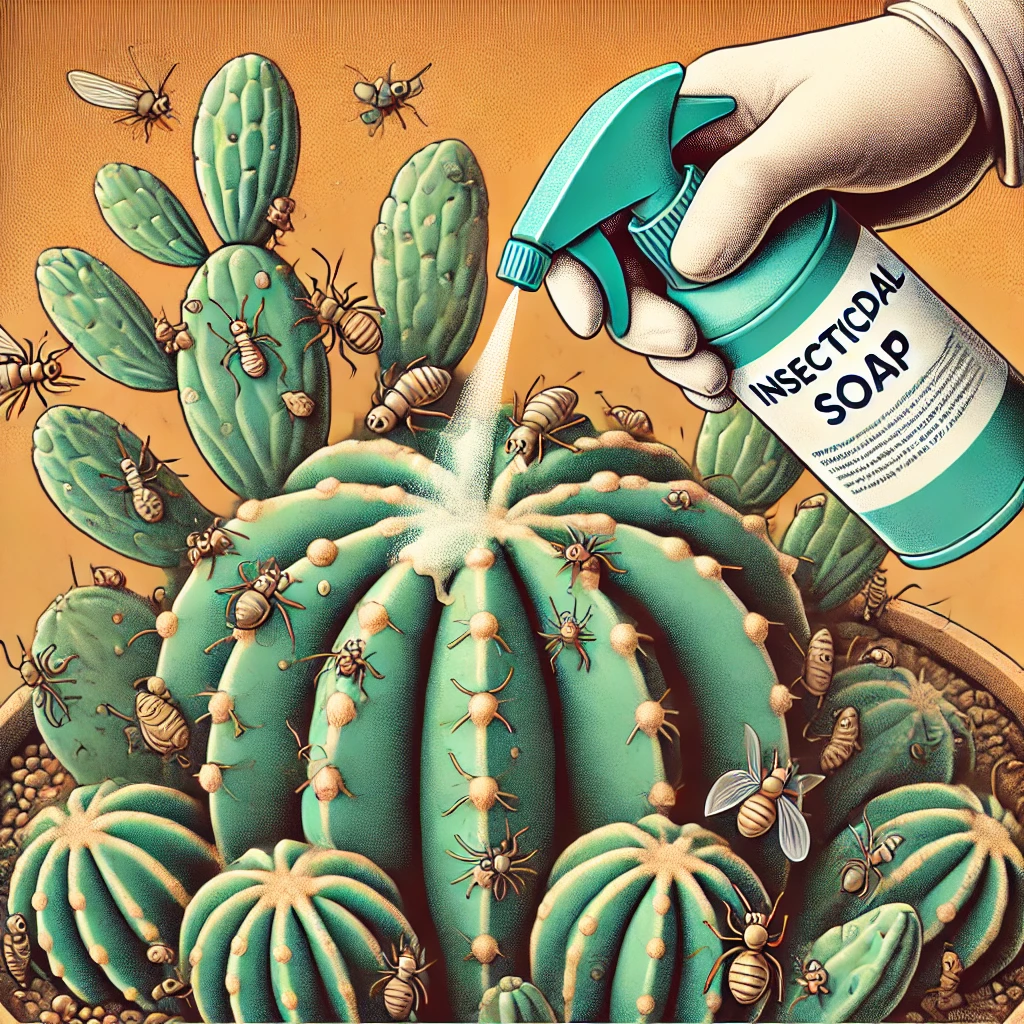
The San Pedro cactus (Echinopsis pachanoi), also known as the mescaline cactus, is native to the Andean regions of South America and is cherished for its striking beauty, rapid growth, and cultural significance. While generally hardy and easy to care for, even this resilient plant isn’t immune to pests. From aphids to mealybugs, the San Pedro cactus, or mescaline cactus, can fall victim to various insects that can hinder its growth and vitality. In this blog, we’ll explore the common pests that target San Pedro cacti and share effective strategies for pest prevention and control.
Understanding Common Pests
1. Mealybugs
Mealybugs are among the most frequent invaders of San Pedro cacti. These small, white, cotton-like pests cluster around the plant’s crevices, feeding on its sap and weakening the cactus over time. Symptoms of a mealybug infestation include yellowing or discolored patches, stunted growth, and a sticky residue on the cactus’s surface due to honeydew secretion.
2. Spider Mites
Spider mites are nearly invisible to the naked eye but leave a trail of destruction in their wake. These pests thrive in dry, dusty conditions and create fine webbing on the cactus. Signs of spider mite infestation include tiny brown or yellow spots on the skin of the cactus and a general decline in plant health.
3. Scale Insects
Scale insects attach themselves to the San Pedro cactus’s surface, forming hard, shell-like coverings. These pests are challenging to detect in their early stages and can cause severe damage if left untreated. The cactus may exhibit discolored areas, slow growth, and, in extreme cases, a decline in overall vigor.
4. Fungus Gnats
While fungus gnats primarily target the soil, they can indirectly affect the health of your San Pedro cactus by damaging its roots. These tiny flying insects are often a sign of overwatering or poor soil drainage, creating a hospitable environment for their larvae.
5. Aphids
Aphids, though less common, can still infest San Pedro cacti. These small, soft-bodied insects cluster on new growth, feeding on sap and excreting sticky honeydew. Aphid infestations often lead to stunted growth and distorted plant shapes.

Preventing Pest Infestations
Prevention is the first line of defense when it comes to protecting your Cactus de San Pedro from pests. Here are some practical steps to minimize the risk of infestations:
1. Maintain Optimal Growing Conditions
Ensure your cactus is grown in well-draining soil and receives adequate sunlight. Including mescalina cactus care tips, such as avoiding overwatering and providing ample airflow, can further enhance its resilience against pests. Proper airflow around the plant can reduce the likelihood of pests like spider mites, which thrive in stagnant, dusty environments. Avoid overwatering, as excess moisture attracts fungus gnats and creates conditions conducive to root rot.
2. Inspect New Plants
When introducing new plants to your collection, carefully inspect them for signs of pests. Isolate new additions for a few weeks to ensure they are pest-free before placing them near your San Pedro cactus.
3. Keep the Area Clean
Regularly remove debris, dead leaves, and weeds around your cactus. A clean environment discourages pests from settling and reduces hiding spots for insects.
4. Use Natural Predators
In an outdoor setting, encourage the presence of beneficial insects like ladybugs and predatory mites, which can help control pest populations naturally.

Treating Pest Infestations
Despite your best efforts, infestations can still occur. Fortunately, several effective treatments can help you eliminate pests and restore your cactus’s health.
1. Mealybugs
- Manual Removal: Use a cotton swab dipped in rubbing alcohol to dab directly onto the mealybugs. This dissolves their protective coating and kills them on contact.
- Neem Oil: Apply a diluted neem oil solution to the affected areas. Neem oil is a natural insecticide that disrupts the pests’ life cycles.
- Insecticidal Soap: Spray the cactus with insecticidal soap, ensuring thorough coverage. Repeat the treatment weekly until the infestation is under control.
2. Spider Mites
- Increase Humidity: Spider mites dislike humid environments. Misting the cactus lightly can deter them, but avoid overdoing it, as excess moisture can lead to other issues.
- Spray with Water: A strong blast of water can physically dislodge spider mites from the plant. Follow up with neem oil or insecticidal soap for lasting effects.
3. Scale Insects
- Scraping: Gently scrape off scale insects using a toothbrush or your fingernail. Be careful not to damage the cactus’s surface.
- Horticultural Oil: Apply horticultural oil to smother the scale insects. This treatment is particularly effective against the immobile adult stage.
4. Fungus Gnats
- Dry Out the Soil: Allow the soil to dry out completely between waterings to kill larvae. Fungus gnats thrive in damp conditions, so reducing moisture is key.
- Sticky Traps: Use yellow sticky traps to capture adult gnats and prevent them from laying eggs.
- Beneficial Nematodes: Introduce nematodes to the soil to target and kill fungus gnat larvae.
5. Aphids
- Blast with Water: Use a strong stream of water to knock aphids off the cactus. This method works best for light infestations.
- Introduce Predators: Ladybugs and lacewings are natural predators of aphids and can help control their population.
- Insecticidal Soap: Apply insecticidal soap to the affected areas, ensuring you cover all sides of the plant.

When to Seek Professional Help
In severe cases where pest infestations persist despite your efforts, it may be necessary to consult a professional. Cactus specialists or pest control experts can assess the situation and recommend advanced treatments, such as systemic insecticides or specialized care techniques.
Reflexiones finales
Caring for a San Pedro cactus can be a rewarding experience, but it’s essential to stay vigilant against pests. By understanding the common culprits and implementing both preventative measures and effective treatments, you can keep your cactus thriving. Regular monitoring and timely intervention are key to ensuring your Cactus de San Pedro remains healthy and free from unwelcome invaders.